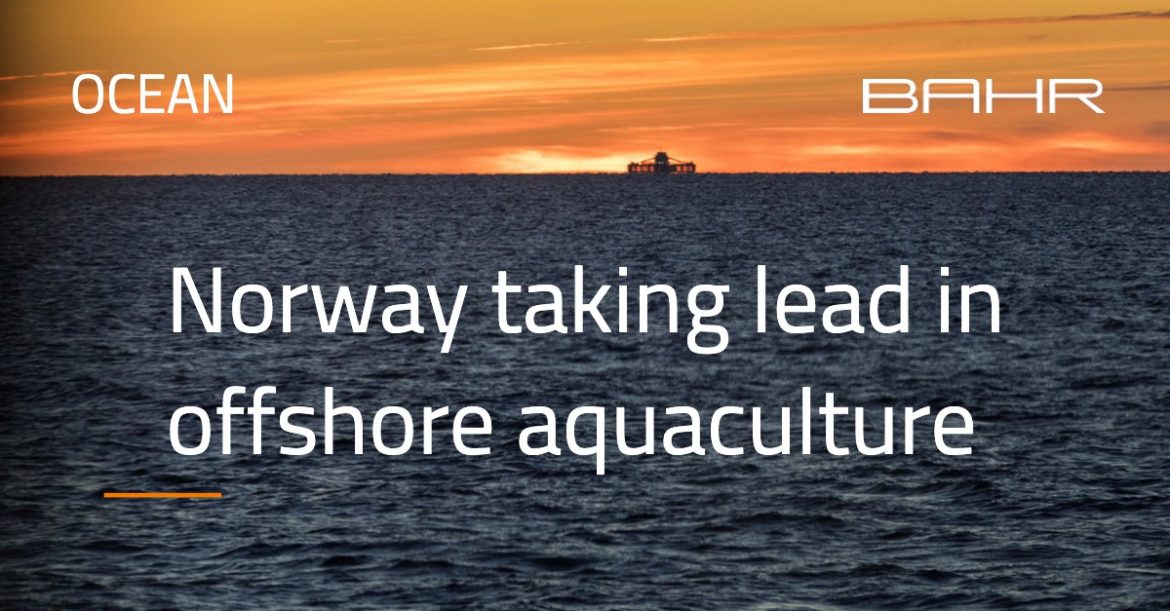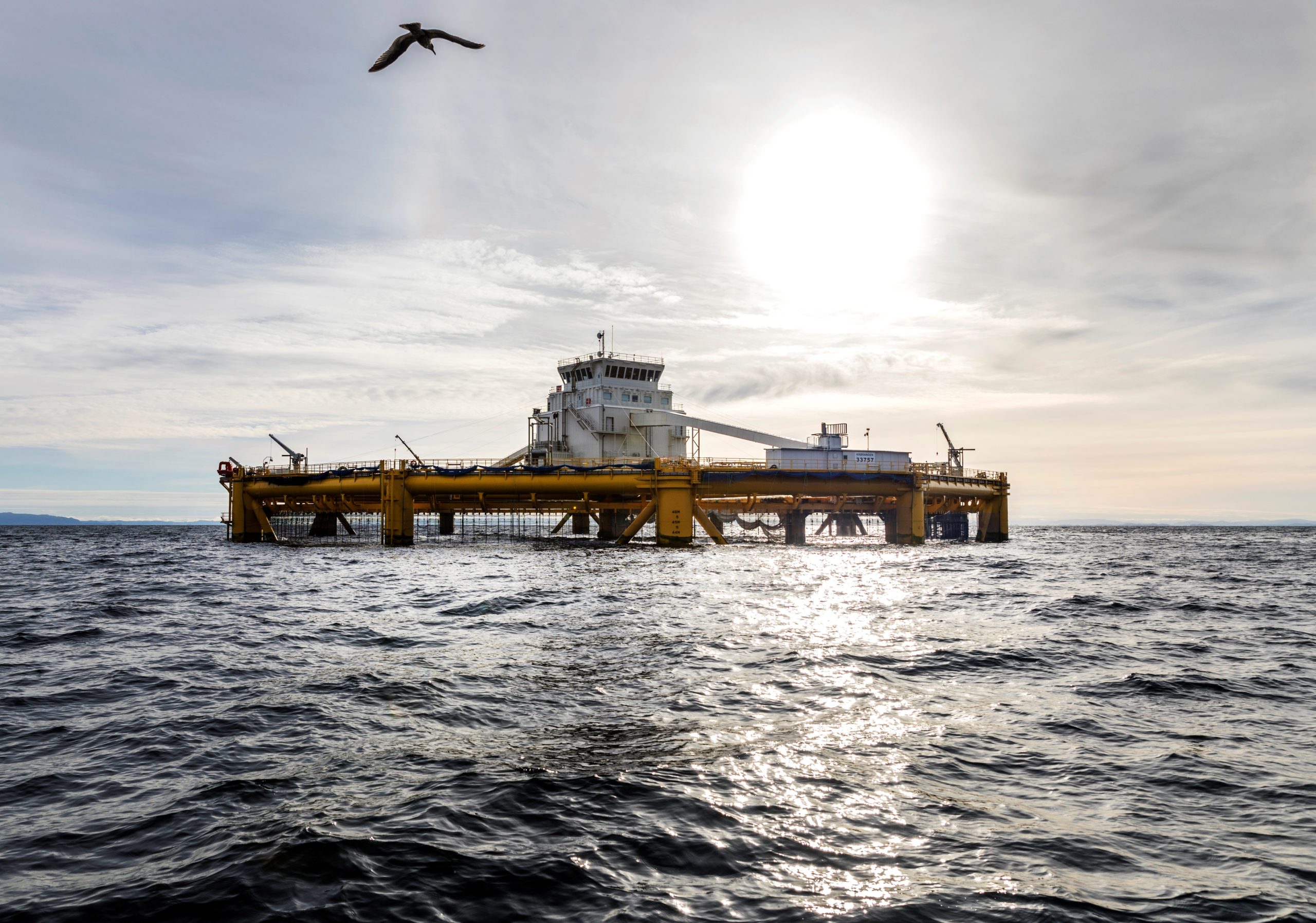OCEAN | Norway taking lead in offshore aquaculture

Potential for growth in Norwegian aquaculture
Aquaculture is now the fastest growing food producing sector in the world and is projected to reach 109 million tonnes produced seafood in 2030, an increase of 32 percent (26 million tonnes) since 2018.[1] According to the outlooks of the Food and Agriculture Organization (FAO), prices in the fishery and aquaculture sector are – in nominal terms – also expected to rise towards 2030.[2]
Norway is Europe’s largest fisheries- and aquaculture nation due to its exceptionally good natural conditions for production, good public management and skilled industry practitioners. According to the Norwegian Seafood Council, Norway exported 3.1 million tonnes of seafood with a value of NOK 120.8 billion in 2021, making this yet another record-breaking year for Norwegian seafood export.[3]
Atlantic salmon and rainbow trout are the most common and valuable species produced in the Norwegian aquaculture industry today, with production of salmon being the most dominant and generating most value. January 2022 was a record-breaking month for salmon exports, with 96 500 tonnes of salmon worth NOK 7.2 billion exported.[4]
To continue the strong growth and to be able to meet the increasing global demands, the aquaculture industry must respond to challenges relating to i.a.:
- limited access to new locations for production;
- fish health and fish welfare; and
- the effects on the environment (e.g. fish escapes, waste and the environmental footprint of fish feed and transport).
Development of offshore aquaculture
Technological development has traditionally been relatively slow in the aquaculture industry. This has changed significantly in recent years, and we are currently finding ourselves in what seems to be a technological revolution in the industry. A strengthened focus on technology and sustainability is now apparent across the entire aquaculture sector.
To spark innovation in the aquaculture industry, the Norwegian government introduced a temporary scheme for so-called development licenses (Nw. ”utviklingstillatelser”) in 2015, which was open for applications between November 2015 and November 2017. Such licenses were awarded to projects that met certain criteria, with the aim of facilitating innovation that could help solve some of the challenges faced by the aquaculture industry, such as those listed above. Some of the projects that were awarded development licenses were concepts for fish farms that could be utilised at more exposed locations compared to traditional aquaculture (so-called offshore aquaculture).

Offshore aquaculture, together with offshore wind, offshore carbon capture and storage, as well as exploration and extraction of deep-sea minerals, are seen as promising new maritime industries in Norway, powering the green transition and with great potential for value creation. The new government in Norway, which took office in October 2021, sees offshore aquaculture as an important future industry and has in its governmental platform stated that it will develop a specific regulatory regime for offshore aquaculture. Building on long-standing experience with salmon farming and offshore technology, together with an increasing political focus, Norway is well positioned to take lead in the development of offshore aquaculture.
Current published research shows that there is a good chance of succeeding with salmon farming in more exposed locations offshore. It is expected that offshore aquaculture may have less of a negative impact on the natural environment compared to traditional aquaculture in open net pens.[5]
An obstacle in proceeding with moving aquaculture further offshore has been the lack of a regulatory framework specially adapted for this form of fish farming. Recent regulatory developments which could bring this new industry a step further is outlined below.
Regulatory framework
The Norwegian Aquaculture Act 2005 (the Aquaculture Act) is the main regulatory framework for aquaculture activities in Norway. The Aquaculture Act also applies for offshore aquaculture.
Aquaculture is a permit-based industry, and in order to carry out aquaculture activities, an aquaculture license is required. The aquaculture license gives the right to production of certain species within defined geographical areas (locations).
The Aquaculture Act does not, however, fully regulate all aspects relevant for aquaculture activities. Aquaculture activities concern, inter alia, the environment, pollution, water usage, live animals and food for human consumption, and additional laws and regulations therefore apply for those carrying out aquaculture activities. For offshore aquaculture, there are further interests to be aligned since the areas suitable for offshore fish farming could also be desirable areas for other industries such as fishing, oil and gas, offshore wind and mineral exploration.
By virtue of existing regulations, much of the framework for offshore aquaculture is already in place, but there will be a need for various adjustments and additions to the regulatory framework to adequately address the different aspects of offshore fish farming.
Special permit regime for offshore aquaculture
On 2 February 2022, the Ministry of Trade, Industry and Fisheries (the Ministry) sent a proposal for a separate permit regime for offshore aquaculture on public consultation (our newsletter is available in Norwegian here). The proposal is the first relating to the establishment of a separate regulatory framework for offshore aquaculture and is an important milestone in what could mark a new era in aquaculture. The consultation deadline is 2 May 2022.
It is proposed that the government decides whether, and in which case what parts of, an area at sea can be opened for offshore aquaculture.
A special regulation will be established for the individual licensing rounds, where pre-qualification requirements and other conditions for participating in a competition may be introduced.
Participants who win the competition will be given a pre-commitment by the Ministry, and must submit a proposal for a program for project-specific impact assessment to the Norwegian Directorate of Fisheries (the Directorate). Guidelines for preparing the program are to be provided in a separate guide. The Directorate will send proposals for programs for consultation to relevant sector authorities and decides the program.
It is proposed that the operator, after carrying out a project-specific impact assessment, applies for a specific location within the area that has been impact assessed. The Directorate may grant a license for an offshore site based on the application and carry out a project-specific impact assessment, provided that the allocation conditions are met, including the allocation of sector permits from relevant authorities. An aquaculture license is granted to one specific location within the sub-area that emerges from the pre-commitment given by the Ministry.
The Norwegian government is currently working on designating suitable locations for offshore aquaculture. As per the request of the Ministry, the Directorate has invited relevant authorities and organisations to provide input to three proposed areas offshore, and the Directorate is now reviewing feedback received before submitting its recommendation to the Ministry.
The government is also working on more detailed regulations for offshore aquaculture such as environment regulations, regulations for health, environment and safety (HSE), technical requirements, fish health and fish welfare.
***
If you have questions relating to the regulatory regime for aquaculture in Norway, please contact our aquaculture team.
